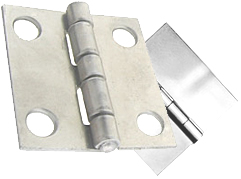
Hinges are available in many different styles. There are butt hinges consisting of two leafs and an interconnected knuckle, loose joint hinges consisting of a fixed pin in one leaf, continuous hinges consisting of long leafs that span the entire height of the surface on which they are used, and many more. In addition to styles such as these, however, some hinges are staked. What is staking exactly, and how does it affect hinges?
The Basics of Staking
Staking is the process of deforming or indenting the knuckle of a hinge so that the pin isn’t able to move.
Most hinges, including butt hinges, feature two leafs and a hollow knuckle. A pin is placed through the center of the knuckle to hold the leafs together. If you install a hinge on a door, you can remove the door by popping the pin out of the knuckle. Simply place a screwdriver under the pin and tap the bottom with a hammer. Once the pin pops out of the top, you can remove the door by lifting it.
Staked hinges still feature the same parts as other hinges, such as two leafs, a hollow knuckle and a pin. The difference is that staked hinges undergo an additional process during production to secure the pin. Known as staking, this process involves punching or indenting the knuckle.
Why Hinges Are Staked
Staking is designed to hold and secure the pin in place. Traditional hinges have a hollow knuckle with smooth and even sides. This makes the pin easy to remove. Staked hinges still have a hollow knuckle, but the knuckle is intended in several places to better secure the pin.
The pin is less likely to fall out of a staked hinge. Even when used in applications where the hinge is sideways or upside down, the pin will remain in the knuckle.
On the other hand, you’ll have a harder time removing the pin from a staked hinge. Pins are oftentimes intentionally removed. As previously mentioned, you may want to remove the pin when taking a door off the frame. Popping the pin out of the knuckle will allow you to remove the door without messing with the two hinge leafs. But staked hinges are designed so that the pin doesn’t move — at least not without extra effort.
In Conclusion
With their deformed knuckle, staked hinges offer better pin security than traditional hinges. Staked hinges are characterized by a deformed or indented knuckle that presses against the pin, thereby holding it in place.
